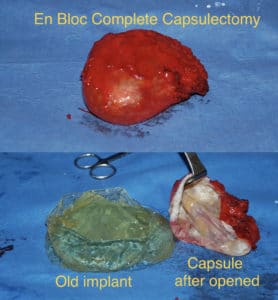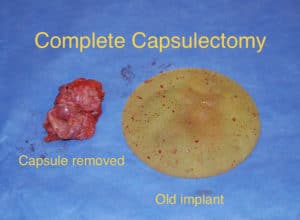This educational writing with accompanying videos will review capsular contracture and its surgical treatment including complete capsulectomy and the En Bloc technique. When breast implants become hard or develop scar tissue around them, it is important to learn about your choices and options. The surgical procedures described in this writing are meticulous, skilled, and demanding. These are operations that I specialize in and perform regularly. This writing and associated videos will review capsular contracture, complete capsulectomy, and the En Bloc technique. I have another educational writing on this topic. The material overlaps but will be valuable to those interested in this topic. Click here to learn more..
Breast augmentation is an extremely successful operation that is performed hundreds of thousands of times each year. Most women get results with breasts that are fuller, bigger, and more youthful. However, like any operation, things occasionally can go wrong. Complications can occur. Capsular contracture is one of the problems that can develop after surgery to enhance the breast.
Overview:
Capsular contracture is the development of scar tissue around the implants. It’s normal to have soft and flexible scar tissue around all implants. However, if the scar tissue hardens, it’s called contracture. Capsular is the adjective of capsule. So capsular contracture literally means scar hardening. That’s why the slang term for this problem is hardening of the implants. This scar tissue can progress and require surgery to fix it. This writing reviews this problem and has two videos that are informative and show the actual dissection of the capsule. Lots of before and after pictures are included in the videos.
Why:
Medicine does not have the definitive answer on why capsular contracture or excessive scar tissue occurs after augmentation. Breast implants are usually associated with a soft and natural result. However, some women will develop hardening or scar tissue formation. The placement of the implant beneath the muscle is believed to be one of the main ways to avoid this problem from happening. This placement does not mean it won’t happen, but it does make the risk very low and hence this is why it is placed there.
Severity or Grades:
The scar tissue can gradually build up and make the examination and breasts hard. This hardening comes in 4 degrees or grades. Grade 1 is considered normal. As the breasts get harder, the number goes up. Grade 4 is the most severe scar tissue and hardening. Grade 4 is often as hard as a baseball and is associated with significant pain.
Treatment:
Options for treatment are predominantly surgical. There are some medicines that are occasionally recommended, but studies have unfortunately shown no significant benefit with the medicines. Surgical options are the mainstay of treatment and are associated with the best results with capsular contracture.
The main surgery choices are cutting the scar tissue and/or its removal. Cutting the tissue, but not removing it, is called capsulotomy. The word ends in “otomy” which means cutting. The scar tissue is cut so the breast can soften and expand. The other main choice is scar removal called capsulectomy. The word ends in “ectomy” which means removal.
Capsulectomy:
There are two types of capsulectomy, partial and complete. Partial removal is just as it sounds. Some of the tissue is removed to allow for treatment of the hardening and softening of the breast. Complete capsulectomy means removal of all scar tissue. Medical studies have shown better results with complete removal, and this is what I recommend most often.
The results of this surgery is usually a return to natural breast shapes and appearances. The hardness is removed by the surgical excision and soft and normal looking breasts is typically achieved. The operation does have risks, and these would be reviewed with you in detail during your office consultation. For those interested, please watch my educational video on complete capsulectomy. I believe it is very informative, and there are lots of before and after pictures at the end.
En Bloc:
En bloc removal is a form or type of complete capsulectomy. This means removal of the implant, called explant, and the surrounding scar in one large piece. The En Bloc technique was first performed for cancer operations and is reviewed in the second video. The technique is a meticulous and demanding operation. It is an operation that I specialize in. I believe this technique leads to the best results with the lowest chances of the scar tissue returning. For those interested, please watch my educational video on En Bloc complete capsulectomy. The video shows some actual operative dissections of the capsules which I find fascinating.
Conclusions:
Capsular contracture can occur after breast enlargement. It is a risk that can require surgery to fix. I specialize in this corrective procedure. The best surgery results come from complete capsulectomy. The En Bloc method is used whenever possible to achieve the most thorough and meticulous removal of scar tissue. I believe this gives the best chances and results. Please come in for a consultation and thorough discussion of your situation.



